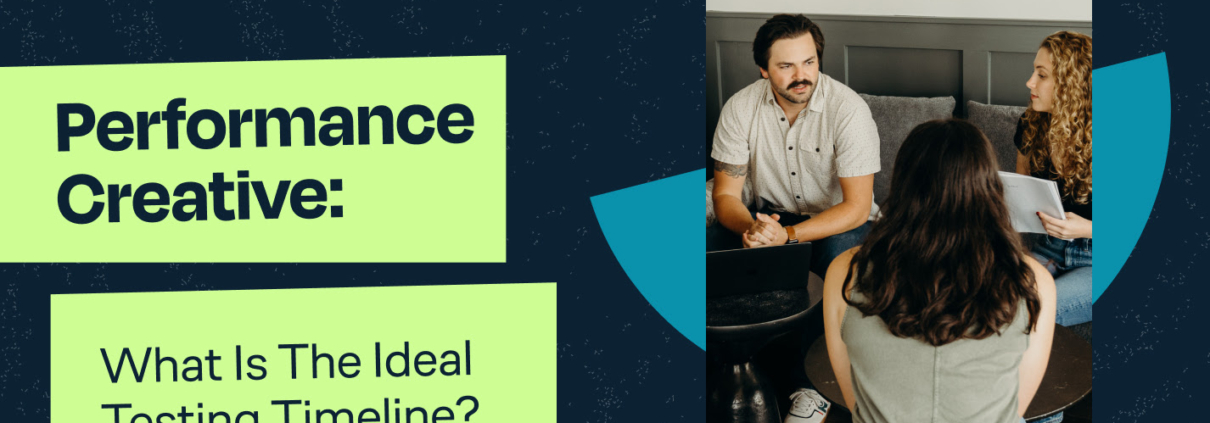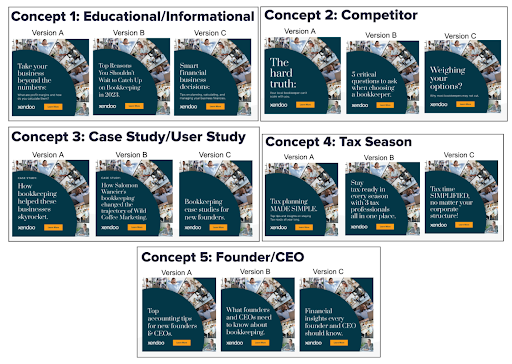Performance Creative: What is the Ideal Timeline and Cadence of Testing and Iterating?
Have you ever bought something from an Instagram or TikTok ad? Did it feel like that ad was specifically written just for you?
If the answer is “yes,” your purchase was the result of a successful performance ad creative testing strategy. No, they’re not listening to your phone calls. They’ve just tried enough different things that they now understand what language and visuals will stop your scroll and make you want to buy.
In a landscape saturated with information and distractions, a brand’s ability to resonate with its audience is a powerful factor of success. Performance ad creative goes beyond traditional advertising, venturing into the realm of storytelling and emotional connection. It’s not just about showcasing products or services; it’s about crafting narratives that spark curiosity, trigger emotions, and ultimately guide potential customers down the conversion funnel.
Performance creative can benefit early-stage brands, scaleups, and more established brands. How? Well, you have come to the right place to learn more 👇
- If you are an early-stage brand, you can use performance creative to invest in your brand development and validate your value props.
- If you are a scaleup, you can use performance creative to build on those brand learnings and test new ways to be competitive.
- If you are a more established brand, you can use performance creative to maximize your paid media results and drive directional growth for your business.
Understanding the Impact of Performance Creative
Performance creative draws the right kind of attention to your brand. It plays a pivotal role in your growth strategy by accelerating brand awareness, customer engagement, and conversion rates. You may think, “But we already make creative for paid media campaigns. How is this approach different from what I’m already doing?” Here are a few differentiators between performance creative vs. a traditional creative approach within paid media campaigns:
|
Traditional Creative |
Performance Creative |
|
| Goal and Purpose |
|
|
| Personalization and Targeting |
|
|
| Production |
|
|
| Measurability |
|
|
In a nutshell, traditional ad creative is about creating big, beautiful assets to garner brand awareness and emotional connections, often with a broader audience and a focus on communicating a brand’s values and identity. Performance ad creative is laser-focused on achieving measurable results and driving immediate actions from the audience. It harnesses data-driven insights, optimization techniques, and strong CTAs to guide users through the funnel.
Finding the Ideal Timeline for Testing and Iterating
The right time for testing is always. And when you think you have learned all you can? Time to re-test. No one likes a stale strategy. 💁
Identifying the right timeline to test and iterate is dependent upon many variables, like your business goals, ideal customer profile, paid media budget, and channel mix.
What are your business goals and what are you hoping to achieve with your test?
- Are you a B2B company looking to drive MQLs? Are you a fintech company looking to acquire new accounts? Are you an eCommerce business looking to drive purchases?
- Are you hoping to validate value propositions? Uncover new ways to be competitive? Drive directional growth? This is where you’ll determine which metrics matter when trying to analyze your data and measure the effectiveness of your test.
Who is your ideal customer profile (ICP)?
- Nailing down who you want to speak to will help you outline what your paid media channel mix should look like. To get the most out of your test, you want to focus your paid media budget on the channels where your customers are most likely to be active.
What is your paid media budget and channel mix?
- Last but not least, the logistics. Depending upon the variables above, you might want to allocate more of your budget towards PPC or maybe social channels.
Setting the Cadence of Testing and Iterating Strategies
Developing a solid testing structure is essential for achieving meaningful results in your performance creative. Here’s how to establish a clear framework:
- Clear Objectives: Begin by defining your specific objectives for testing. Whether you aim to increase conversions, enhance click-through rates, or optimize ad spend, having well-defined goals is paramount.
- Budget Allocation: Allocate the necessary resources and budget to support your testing efforts. This includes setting aside funds for creative production, ad spend, and any tools or platforms required for analysis.
- Testing Timelines: Determine the frequency at which you’ll conduct tests. Consider running A/B tests on a regular basis, such as monthly or quarterly, to maintain a consistent and data-driven approach to optimization. Your cadence will be determined by your budget, your goals, and the competitive landscape.
| Use case | Frequency | Rationale | Funnel Stage |
|---|---|---|---|
| B2B Company Driving MQLs | 4-6 weeks | Monthly testing allows quick adjustments for lead generation in the awareness and consideration stages. | Top and Middle |
| eCommerce Business Looking to Drive Purchases | 4-6 weeks | Monthly testing helps respond swiftly to market dynamics, ideal for consideration and decision stages. | Middle and Bottom |
| Scaleup Hoping to Validate Value Propositions | 8-12 weeks | Quarterly testing allows thorough data gathering for value proposition validation in the awareness and consideration stages. | Top and Middle |
| Established Brand Looking to Acquire New Accounts | 8-12 weeks | Quarterly testing aligns with industry changes and gives ample time for decisions in the consideration and decision stages. | Middle and Bottom |
Leveraging customer behavior insights and determining which metrics matter
Reading your data and selecting the right (i.e. most informative) metrics are key to data-driven decision-making in performance creative. Here’s how to do it effectively:
- Segmentation: Once you have customer profiles, segment your audience based on relevant criteria, such as age, location, or purchasing behavior. This segmentation allows for more personalized creative and messaging.
- Key Metrics: Identify the metrics that align with your testing objectives. Depending on your goals, these may include click-through rates (CTR), conversion rates, return on ad spend (ROAS), or cost per acquisition (CPA). Choose the metrics that directly measure the success of your testing efforts.
- Data Analysis Tools: Invest in data analysis tools or platforms that help you collect, analyze, and interpret customer behavior data. Platforms like Google Analytics, social media insights, or ad campaign management tools can provide valuable insights for informed decision-making.
By following these steps, you can effectively structure your testing approach and make data-driven decisions based on customer insights and relevant metrics.
Best practices for optimizing campaigns
Utilizing A/B testing and multivariate testing methods
What is the most important part of a test? The results! But how do you get the most accurate results that tell the full story? Isolating variables. Regardless of if we’re looking to validate messaging or drive directional growth, we will look at the same key variables – and these must remain equal to isolate the messaging:
- Same Budget and Bidding Strategy: To keep your tests consistent, allocate the same budget and employ an identical bidding strategy across the variables you’re assessing. This ensures that the financial aspects do not introduce confounding factors into your analysis.
- Same Key Audiences: Identical audience segmentation is crucial. Ensure that the audience groups you’re testing your creative against are based on the same criteria. This way, you’re comparing apples to apples and not introducing bias due to audience differences.
- Same Length of Time Tested: To prevent time-related discrepancies, run your tests for the same duration. If one test runs longer than another, you risk introducing temporal factors that could skew your results.
Applying testing results to refine campaigns
Once you’ve meticulously conducted your A/B and multivariate tests and obtained accurate results, it’s time to apply these findings to refine your campaigns. This step is where the magic happens as you translate insights into action:
- Optimize Creative Assets: Use the results to refine and enhance your creative assets. Whether it’s tweaking ad copy, adjusting visuals, or experimenting with different CTAs, the data should inform your creative decisions.
- Budget Reallocation: Based on the performance data, consider reallocating your budget to the high-performing variants. This ensures that your financial resources are channeled effectively towards the best-performing elements.
- Iterative Testing: The learning process never truly ends. Continue to iterate, refine, and test new creative variations. The insights gained from previous tests should guide your ongoing campaign optimization efforts.
- Scale Success: If certain elements consistently outperform others, consider scaling those elements across your campaigns. Replicating successful strategies ensures consistent growth and results.
By incorporating these best practices into your campaign optimization process, you’ll not only achieve more robust results but also maintain a competitive edge in the dynamic landscape of performance creative.
Creative Testing in Action
To gain deeper insights into our creative performance, we made a critical adjustment to the way we flighted creative for an e-commerce partner. We isolated our creative testing campaigns and introduced a dedicated traffic campaign focused on driving users to their site. This seemingly minor change had a significant impact.
By isolating our creative testing in this controlled environment, we’ve maintained the strength of broader campaigns while gathering vital intent-based click data. This data empowered us to make more informed creative decisions that resonate better with our audience–in the right place at the right time.
Build on validated value props and test new ways to be competitive
For one of our bookkeeping partners, we had historically run brand campaigns on LinkedIn, but we were looking to level this up to capture quality leads. To do this, we wanted to confidently go into production for Document Ads with valuable ideas for content.
We put together a multi-step testing strategy to leverage the learnings to date:
- Step 1 – Paid Media: Pull a historical creative analysis that focused on the themes of the top performing ad creative
- Step 2 – Creative: Outline a creative testing framework and produce the creative assets
| Creative Theme | Topic 1 | Topic 2 | Topic 3 |
| Informational / Educational | Take your business beyond the numbers: What are profit margins and how do you calculate them? | 5 Reasons You Shouldn’t Wait to Catch Up on Bookkeeping in 2023 | Smart financial business decisions: Tips on planning, calculating, and managing your business finances. |
| Competitor | The hard truth: your local bookkeeper can’t scale with you | 5 critical questions to ask when choosing a bookkeeper | Weighing your options? How to know you’re choosing the right bookkeeper |
| Case Study / User Story | Case Study For Numbers: How bookkeeping helped these business skyrocket | Case Study: How Salomon Wancier’s bookkeeping changed the trajectory of Wild Coffee Marketing. | Bookkeeping case studies for new founders |
| Tax / Seasonal | Tax planning MADE SIMPLE. Top tips and insights on staying Tax ready all year long. | Stay tax-ready in every season with 3 tax professionals – all in one place | Tax time SIMPLIFIED, no matter your corporate structure! |
| Founder / CEO | Secure your business’s financial future: Top accounting tips for new founders & CEOs. | Top accounting tips for Founders : What founders and CEOs need to know about bookkeeping. | Bookkeeping power moves: Financial insights every founder and CEO should know. |
Here is how the assets came to life in concept form: Xendoo: July 2023 Social Ad Creative
- Step 3 – Paid Media: Launch the new assets in a campaign that answers the question of which content themes are the most engaging
- In order to get an understanding of the most engaging content themes, we set up a campaign that optimized for engagement and allowed each creative theme to receive the same amount of spend so that we had an accurate read on which theme was the most engaging.
- Step 4 – Paid Media: Evaluate the results with a new creative analysis
- Since we were optimizing for engagement, we looked at metrics, like cost per click, click-thru rate and time on site. Since we were able to spend an equal amount on each creative theme, we were able to definitively say that Educational / Informational and Founder / CEO themes were the most engaging – Specifically, “Top Reasons You Shouldn’t Wait to Catch Up on Bookkeeping in 2023” and “Top Accounting Tips for New Founders & CEOs”.
- Step 5 – Creative: Use these findings to determine the top two topics for Document Ad content development
- We utilized these learnings to produce two key pieces of content:
- 2023 End of Year Checklist Tax for CEOs and Founders
- Top Reasons You Shouldn’t Wait to Catch Up on Bookkeeping in 2023
- And built upon this by creating three variations of each – totaling six PDFs to test with the Document Ads campaign type on LinkedIn.
- We utilized these learnings to produce two key pieces of content:
Our journey continues as we aim to maximize paid media results and drive directional growth. The insights gained from this comprehensive testing approach provide the stepping stones for our future tests, ensuring we remain at the forefront of innovation and audience engagement. Stay tuned for the exciting developments ahead!
Conclusion
Phew! There are so many variables that go into thoughtful performance creative, data-driven testing strategies and more importantly how these two come together to maximize paid media campaigns.
To simplify: Data + Creative = BFFs when it comes to testing, iterating, and scaling performance. Got questions on how we can help your brand leverage testing with performance creative? Hit us up – Our team of creative and paid media experts have the skills and experience needed to supercharge your campaigns.

Hi there — I’m Kate, a Social Ads Strategist based in Knoxville, TN. I have over four years of experience in social media, focused predominantly on paid social media planning and buying. When I am not at my computer, I am likely hanging out with my dog, Benji, or cooking up something good in the kitchen.







